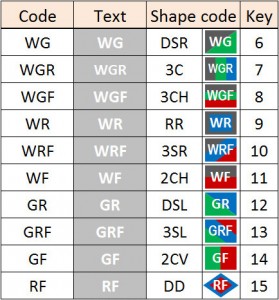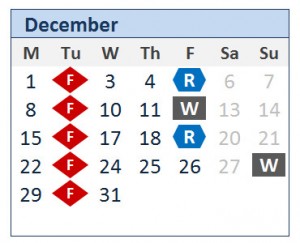1. Month design
 The development process starts with the client’s overall conceptual design for the calendar. The first stage is to agree on how each month table will look (example shown opposite) and then on the grid of months, set out to fit within the overall design. The calendar insert will need to match the colours and fonts in the shell document, fit into the space allocated and – most important – remain clear and legible at the planned viewing size.
The development process starts with the client’s overall conceptual design for the calendar. The first stage is to agree on how each month table will look (example shown opposite) and then on the grid of months, set out to fit within the overall design. The calendar insert will need to match the colours and fonts in the shell document, fit into the space allocated and – most important – remain clear and legible at the planned viewing size.
2. Shape Codes
 Having agreed on the overall design, shapes, codes and colours for collections are specified. These are set for each of the unique collections separately as shown in the example opposite. The order in which they should appear on the key can also be chosen. In the case shown there are two instances of the “W” code (for black bin / general waste) as the client had a mix of 7 day and 14 day collections, so the entry appears twice – once for each.
Having agreed on the overall design, shapes, codes and colours for collections are specified. These are set for each of the unique collections separately as shown in the example opposite. The order in which they should appear on the key can also be chosen. In the case shown there are two instances of the “W” code (for black bin / general waste) as the client had a mix of 7 day and 14 day collections, so the entry appears twice – once for each.
Note the use of shape codes (Rectangle, Oval, Hexagon and Diamond) to chose what symbol to show for each collection
3. Combined-collection codes
 Once the main collections codes are set, The system generates suggested split colour shapes and codes for combinations of up to 5 collections that may all fall on the same day. The automatically generated “combo” codes don’t always produce satisfactory results so the system allows the standard shapes and colours to be substituted to help improve legibility.
Once the main collections codes are set, The system generates suggested split colour shapes and codes for combinations of up to 5 collections that may all fall on the same day. The automatically generated “combo” codes don’t always produce satisfactory results so the system allows the standard shapes and colours to be substituted to help improve legibility.
Some examples are shown here including more complex shape codes like DSR (diagonal, slant right), 3C (3-colour), 3CH (3-colour, horizontal) 3SL (3-colour, slant left), and DD (diamond-within-diamond).
The symbols can be overlaid with the date, a nemonic code (as shown in the examples) or left plain
4. Outline codes
 Outline codes are used to add a coloured border round any collection code falling on a specific day, where there may be a special collection arrangement. It’s also possible to add an extra key symbol to explain what the highlight means.
Outline codes are used to add a coloured border round any collection code falling on a specific day, where there may be a special collection arrangement. It’s also possible to add an extra key symbol to explain what the highlight means.
 In the example on the left, an outline code has been used to show a bank holiday (18th April). This key on this calendar would include a yellow outline box, with a caption that asks the user to check the local press / media for collection information for this day. This approach is useful if you know that collections are likely to change but you can’t specify the exact arrangements at the time of calendar distribution.
In the example on the left, an outline code has been used to show a bank holiday (18th April). This key on this calendar would include a yellow outline box, with a caption that asks the user to check the local press / media for collection information for this day. This approach is useful if you know that collections are likely to change but you can’t specify the exact arrangements at the time of calendar distribution.
5. Holiday rescheduling
 The system can also show collection rescheduling on public or bank holidays instead of using outline codes, if these operational arrangements are known in advance. The example shows a typical re-allocation. The 26th December (Boxing day) collection has been moved to Sunday 28th. Similar rescheduling could be shown for collections falling on Christmas day, New Years day and any other days, when re-scheduling arrangements are known in advance.
The system can also show collection rescheduling on public or bank holidays instead of using outline codes, if these operational arrangements are known in advance. The example shows a typical re-allocation. The 26th December (Boxing day) collection has been moved to Sunday 28th. Similar rescheduling could be shown for collections falling on Christmas day, New Years day and any other days, when re-scheduling arrangements are known in advance.
Further Options
The system is very flexible and can handle most scenarios – but we’re not able to show examples of them all here. If you have a special requirement that we’ve not already found a solution for, then we’ll see if we can develop a solution specially for you. Examples include:
-
Special collections – for example, to show a one-off collection (e.g.Christmas tree pick-up) that happens just once in the year.
- Exceptions – typically used to show when seasonal collections (like green waste) start and stop.
- Phasing – useful when a collection is either introduced, changed or withdrawn at different times, for different groups of properties.
- Major change “mid-stream”. We can show an existing collection regime at the start of the calendar, and the transition to a new regime later on. We can handle subtle changes, or a switch to a radically different type of collection, and completely new collection days.
- Special layouts – for example an asymmetric calendar grid to free up space for key messages (see Example 9 in the Calendar Examples page – a 12 month calendar in a 5 x 3 grid)
- Any other “bespoke” requirements that you may have.
We hope this explanation will give you an idea of what our system can do, and of how flexible the options are. Nevertheless, if there’s something special you need for your calendars that we’ve not shown here then do please get in touch to discuss your requirements.